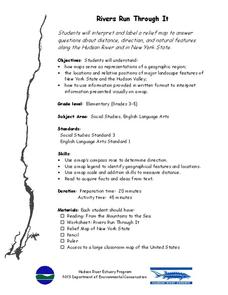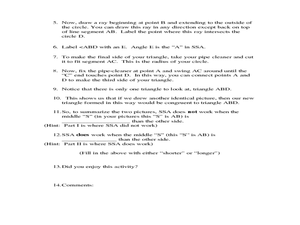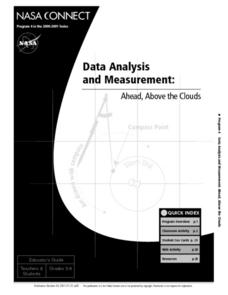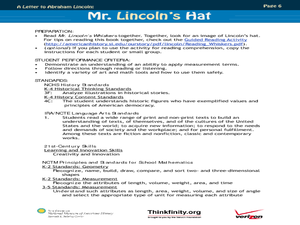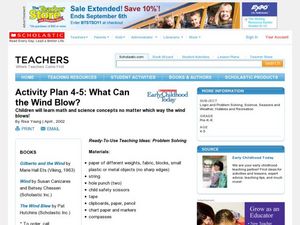Curated OER
Rivers Run Through It
Using a relief map of New York State, learners answer questions about the distance between different cities, identify bodies of water, and more. First, they discuss vocabulary related to the Hudson River area. Then, they complete a...
Curated OER
Mapmaking
Students examine the craft of cartography and how the Lewis and Clark expedition created and used maps. They analyze maps, read a handout, create a map, participate in a mini expedition and map out a route based on travel directions,...
Curated OER
Congruent Triangles
Young scholars explore the concept of congruent triangles. In this congruent triangles lesson plan, students use Cabri Jr. to construct two congruent triangles using circles. Young scholars determine if the two triangles are...
Curated OER
Why Doesn't SSA Work?
Students investigate the relationship between angles and their sides. In this geometry instructional activity, students prove why SSA does not work as a true angle side relationship theorem.
Curated OER
Follow the Sun
Students use a simple model of the Earth and Sun as seen from space to explore the sun's apparent movement across the sky over the course of a day and year. They consider the apparent direction of movement and changes in the sun's angle.
Curated OER
Wales: An Interdisciplinary Unit
Young scholars practice basic map and geographic skills as they compare Oregon to Wales. Students color map of Wales and Oregon using color codes to distinguish between land, water, and bordering nations or states, listen to stories and...
Curated OER
Book: First Encounters Between Spain and the Americas: Two Worlds Meet
Young scholars, after reading Chapter 1 in the book, "First Encounters Between Spain and the Americas: Two Worlds Meet," design and create a map of the Aztec Empire at the time of the first contract with the Spanish. They create the map...
Curated OER
Coral Reef Geography
In this coral reef geography instructional activity, students find locations of reefs on a globe or map. There are 10 instructions to follow. There is no map provided--an atlas, globe or map is needed.
Curated OER
A Map Mystery
Second graders solve a map mystery. In this technology lesson plan, 2nd graders develop an awareness of maps and the symbols associated with maps as they the "Neighborhood Map Machine."
Curated OER
Basic Electromagnetism and Electromagnetic Induction
In this electromagnetism and electromagnetic induction activity, students answer 12 questions about electricity, about the magnetic fields in given diagrams, about the right-hand rule and about electric current and voltage in magnetic...
Curated OER
Waldseemuller's Map: World 1507
Students investigate the 1507 word map. In this world geography lesson, students examine the details of each section of the map and then draw conclusions about how the people of 1507 understood the world. Students are evalated on...
Curated OER
Plants 'n' Bugs
Second graders experiment to find if pollinators have color preferences. In this plant and bug instructional activity, 2nd graders gather information about how flowers pollinate. Students participate in a pollination...
Curated OER
Rocket Car
Learners construct a balloon-powered rocket car from a Styrofoam tray, pins, tape, and a flexible straw, and test it along a measured track on the floor. They experiment with ways of increasing the distance the rocket car travels.
Curated OER
Data Analysis and Measurement: Ahead, Above the Clouds
Students explore and discuss hurricanes, and examine how meteorologists, weather officers, and NASA researchers use measurement and data analysis to predict severe weather. They plot points on coordinate map, classify hurricanes...
Curated OER
Mr. Lincoln's Hat
Bring out the inner artist with this Abraham Lincoln lesson. Elementary students work on a home project creating a hat similar to Abraham Lincoln's hat. They will use geometry and measurement to create the scale of the hat, then...
Curated OER
What Can the Wind Blow?
Students observe math and science concepts no matter which way the wind blows. In this early childhood problem solving lesson, students will develop science, math, and observation skills as they learn about the wind.
Curated OER
Monochromatic Painting
Students create a piece of monochromatic art. In this monochromatic art lesson, students design a piece of art and analyze their painting objectively. Students connect color and emotions.
Curated OER
Ecotourism in National Parks and Wilderness
Students develop a plan for ecotourism after researching a nearby national park or wild area.
Curated OER
Design an Island
Students explore islands. They create a two- or three-dimensional map of an island. They explain how the topography of an area influences the location of water sources, ecosystems, and human settlements. Lesson includes adaptations for...
Curated OER
Blast from the Past
Students analyze historic artifacts to help gain an understanding of how the past has impacted their lives. They explain ways "design" can be both a noun and a verb. Students use internet resources to view and learn about artifacts that...
Curated OER
The Reasons for the Seasons
Sixth graders conduct a controlled investigation to determine the length of the sun's shadow on a fixed object (i.e., flagpole, telephone pole, etc.) over a three-day period (one day in the fall, one in the winter, and one in the...
Curated OER
Magnetic Car
For this magnetic car worksheet, students learn how to use simple household items to create a magnetic car. Students learn that magnets have two poles and when the same poles face each other it causes a force of repulsion which moves...
Curated OER
Chinese Inventions
Students identify inventions as coming from China. In this Chinese inventions lesson, students are given a list of common items such as cast iron, a wheelbarrow, and the decimal system, then conduct research to identify where they were...
